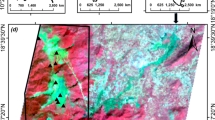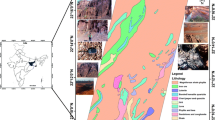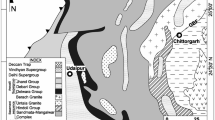Abstract
This paper present the results of a preliminary study to assess the potential of the visible, NIR and SWIR energy of the EMR in differentiating iron ores of different grades in a rapid manner using hyperspectral radiometry. Using different iron ore samples from Noamundi and Joda mines, Jharkhand and Orissa, states of India, certain spectro-radiometric measurements and geochemical analysis were carried out and the results have been presented. It was observed that the primary spectral characteristics of these iron ores lie in the 850 to 900 nm and 650–750 nm regions. The spectral parameters for each curve used for studying the iron ores are: (i) the slopes of the spectral curve in 685–725 nm region; (ii) position of the peak with respect to wavelength in 730–750 nm region and (iii) radius of curvature of the absorption trough in the 850–900 nm region. Comparison of these spectral parameters and the geochemistry of the samples indicates that the position of the peak of the curve in 730–750 nm region shifts towards longer wavelength with increasing iron oxide content, while the slope of the curvature in the 685–725 nm region has a strong negative correlation with the iron oxide content of the samples. Similarly, a strong negative correlation is observed between the radius of curvature of the 850–900 nm absorption trough and the iron oxide content. Such strong correlations indicate that hyperspectral radiometry in the visible and NIR regions can give a better estimate and quantification of the grades of iron ores. This study has demonstrated that generation of empirical models using hyperspectral radiometric techniques is helpful to quantify the grade of iron ores with limited geochemical analysis.













Similar content being viewed by others
References
Clark, R. N. (1999). Chapter 1: Spectroscopy of rocks and minerals, and principles of spectroscopy. In A. N. Rencz (Ed.), Manual of remote sensing, volume 3, remote sensing for the earth sciences (pp. 3–58). New York: Wiley.
Clark, R. N., & Roush, T. L. (1984). Reflectance spectroscopy: quantitative analysis techniques for remote sensing applications. Journal of Geophysics Research, 89, 6329–6340.
Ghosh, P. K. (1952). Directory of Indian Mines and Metals. Calcutta. Mining Geological and Metallurgical Institute of India, 268.
Gradstein, F., Ogg, J., & Smith, A. (2008). A geologic time scale (p. 5). Cambridge: Cambridge University.
Gupta, R. P. (2003). Remote Sensing geology (2nd ed.). Berlin: Springer.
Kumar, R. (1986). Fundamentals of historical geology and stratigraphy of India (pp. 76–77). New Delhi: Willey Eastern Limited.
Malthus, T. J., & Madeira, A. C. (1993). High resolution spectroradiometry: spectral reflectance of field bean leaves infected by Botrytis fabae. Remote Sensing of Environment, 45(1), 107–116.
Milton, E. J. (1987). Review article principles of spectroscopy. International Journal of Remote Sensing, 8, 1807–1827.
Mohapatra, B. K., Singh, P. P., Mishra, P., & Mahant, K. (2008). Detrital iron-ore deposits in the iron ore group of rocks, northern Orissa, eastern India. Australian Journal of Earth Sciences, 55, 1139–1152.
Morris, R. V., Lauer, H. V., Lawson, C. A., Gibson, E. K., Jr., Nace, G. A., & Stewart, C. (1985). Spectral and other physiochemical properties of submicron powders of hematite, maghemite, maghemite, goethite, and lepidochrosite. Joural of Geophysics Research, 90, 3126–3144.
Nicolas, B. J., Mukhopadhyay, J., & Gutzmer, J. (2008). Genesis of high-grade iron ores of the archean iron ore group around Noamundi, India. Economic Geology, 103(2), 365–386.
Sarkar, S. N., & Saha, A. K. (1962). A revision of the Precambrian stratigraphy and tectonics of Singhbhum and adjacent region. Quarterly Journal Geological, Mining and Metallurgical Society (India), 34, 97–136.
Tucker, C. J. (1977). Asymptotic nature of grass canopy spectral reflectance. Applied Optics, 16, 1151–1156.
Acknowledgements
The authors are thankful to M/S TATA Steel, Jamshedpur for the support in the work. Dr.S.Sistla and Dr. Samita Bhattacharjee of Automation Division, and Dr. Mohan Rao, Natural Resources Division, Tata Steel, Jamshedpur are thanked for their support to carry out this work.
Author information
Authors and Affiliations
Corresponding author
About this article
Cite this article
Thangavelu, M., Shanmugam, S. & Bhattacharya, A.K. Hyperspectral Radiometry to Quantify the Grades of Iron Ores of Noamundi and Joda Mines, Eastern India. J Indian Soc Remote Sens 39, 473–483 (2011). https://doi.org/10.1007/s12524-011-0109-z
Received:
Accepted:
Published:
Issue Date:
DOI: https://doi.org/10.1007/s12524-011-0109-z




